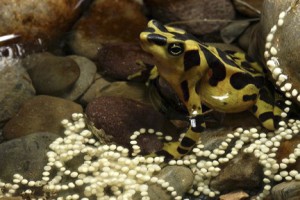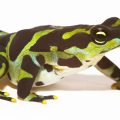Saving amphibians on the brink of extinction
Eight institutions, including the National Zoo and the Tropical Research Institute have formed a joint venture to save amphibians from the brink of extinction in the eastern region of Panama—an area rich with diverse amphibian species. Experts from the Zoo, STRI, Africam Safari Park, the Cheyenne Mountain Zoo, Defenders of Wildlife, the Houston Zoo, Summit Municipal Park and the Zoo New England have pooled their expertise and resources to create the Panama Amphibian Rescue and Conservation Project.
Photo: (Click on thumbnail for full-size image.) The blue poison dart frog can release toxins from its skin that are distasteful and potentially lethal. Its bright color serves as a warning to would-be predators. (Photo by Jessie Cohen)
A global assessment of all 5,743 known amphibian species has found that one-third of them are in imminent danger of extinction because of disease caused by a pathogen known as the chytrid fungus, according to the American Association for the Advancement of Science.

Panamanian golden frogs are extinct in the wild, primarily because of the chytid fungus, which causes a disease first identified by scientists at the National Zoo in 1999. The Zoo is involved with their conservation through a captive breeding program. Here, a female is seen with her recently laid eggs. (Photo by Mehgan Murphy)
“This unparalleled speed of loss to amphibians deserves an immediate and comprehensive global response,” Brian Gratwicke, NZP biologist and project manager of the Amphibian Rescue and Conservation Project, explains. “Time is of the essence, and we need to save these important creatures for their direct cultural, biomedical and ecological impact on human lives.”
The institutions involved in the project have collectively pledged more than $750,000 in cash and in-kind donations during the next three years.
The project will consist of three distinct and complementary parts: the ongoing operation of El Valle Amphibian Conservation Center in western Panama, run by the Houston Zoo; the Amphibian Chytrid Cure Research Program to be initiated at the Zoo in collaboration with Vanderbilt University; and the construction and operation of the new Summit Park Amphibian Rescue Center in Panama.
Eastern Panama is home to at least 121 amphibian species (61 percent of all the amphibians of Panama) and is a stronghold for at least 50 to 60 species listed as “critically endangered,” “endangered” or “data deficient” by the International Union for Conservation of Nature.

The tiger salamander is among those amphibians threatened by the chytid fungus. (Photo by Jessie Cohen)
If amphibians become extinct, one of the most notable effects on humans would be the loss of amphibian-related medicinal potential. Scientists worldwide are studying a number of secretions emitted from amphibians’ skin. The animals themselves use these secretions to communicate with each other, to find mates and as defense against enemies. For humans, these chemicals can mean breakthroughs in medicines, including antibiotics and possible cancer-fighting drugs. In fact, studies with antimicrobial peptides in amphibian skin by Dr. Louise Rollins-Smith, one of the world’s leading amphibian immunologists, has potential use in HIV treatment.
Posted: 24 May 2009








